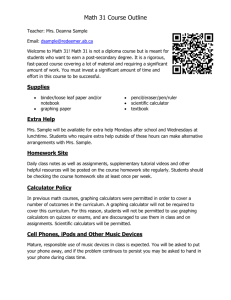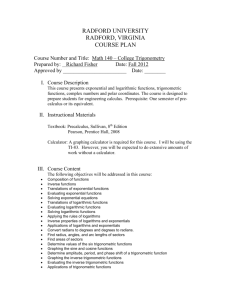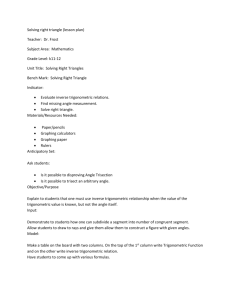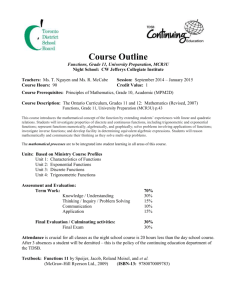MTH 175 PRECALCULUS – Course Objectives f f
advertisement
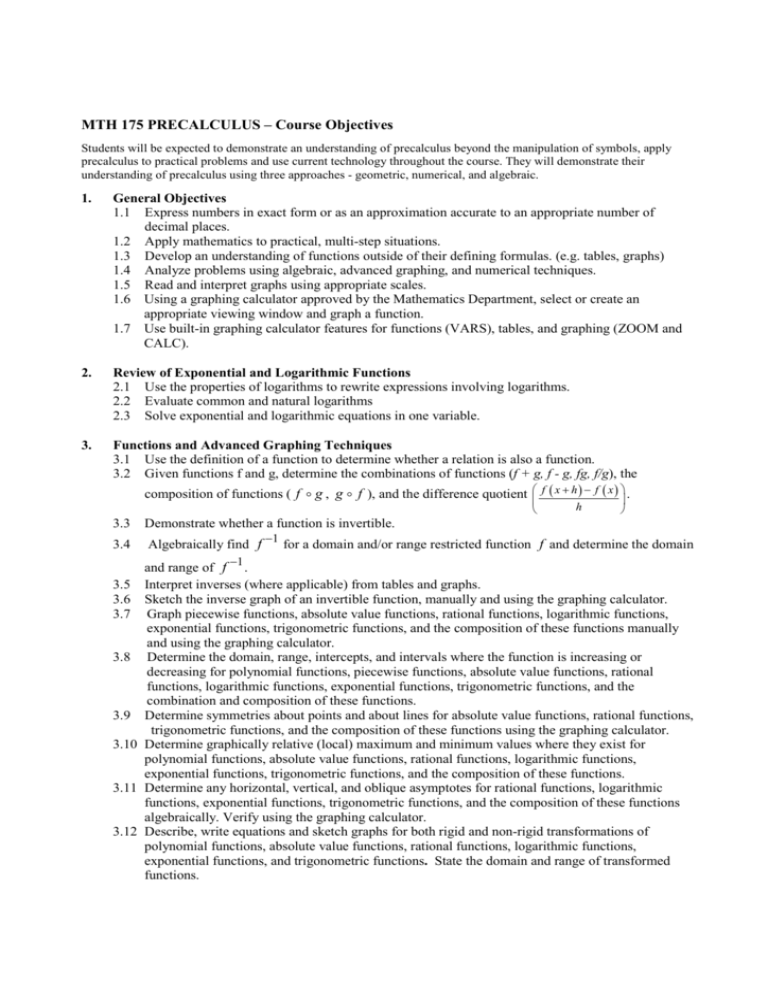
MTH 175 PRECALCULUS – Course Objectives Students will be expected to demonstrate an understanding of precalculus beyond the manipulation of symbols, apply precalculus to practical problems and use current technology throughout the course. They will demonstrate their understanding of precalculus using three approaches - geometric, numerical, and algebraic. 1. General Objectives 1.1 Express numbers in exact form or as an approximation accurate to an appropriate number of decimal places. 1.2 Apply mathematics to practical, multi-step situations. 1.3 Develop an understanding of functions outside of their defining formulas. (e.g. tables, graphs) 1.4 Analyze problems using algebraic, advanced graphing, and numerical techniques. 1.5 Read and interpret graphs using appropriate scales. 1.6 Using a graphing calculator approved by the Mathematics Department, select or create an appropriate viewing window and graph a function. 1.7 Use built-in graphing calculator features for functions (VARS), tables, and graphing (ZOOM and CALC). 2. Review of Exponential and Logarithmic Functions 2.1 Use the properties of logarithms to rewrite expressions involving logarithms. 2.2 Evaluate common and natural logarithms 2.3 Solve exponential and logarithmic equations in one variable. 3. Functions and Advanced Graphing Techniques 3.1 Use the definition of a function to determine whether a relation is also a function. 3.2 Given functions f and g, determine the combinations of functions (f + g, f - g, fg, f/g), the composition of functions ( f g , g f ), and the difference quotient f ( x + h ) − f ( x ) . 3.3 3.4 h Demonstrate whether a function is invertible. Algebraically find f −1 for a domain and/or range restricted function f and determine the domain and range of f −1 . 3.5 Interpret inverses (where applicable) from tables and graphs. 3.6 Sketch the inverse graph of an invertible function, manually and using the graphing calculator. 3.7 Graph piecewise functions, absolute value functions, rational functions, logarithmic functions, exponential functions, trigonometric functions, and the composition of these functions manually and using the graphing calculator. 3.8 Determine the domain, range, intercepts, and intervals where the function is increasing or decreasing for polynomial functions, piecewise functions, absolute value functions, rational functions, logarithmic functions, exponential functions, trigonometric functions, and the combination and composition of these functions. 3.9 Determine symmetries about points and about lines for absolute value functions, rational functions, trigonometric functions, and the composition of these functions using the graphing calculator. 3.10 Determine graphically relative (local) maximum and minimum values where they exist for polynomial functions, absolute value functions, rational functions, logarithmic functions, exponential functions, trigonometric functions, and the composition of these functions. 3.11 Determine any horizontal, vertical, and oblique asymptotes for rational functions, logarithmic functions, exponential functions, trigonometric functions, and the composition of these functions algebraically. Verify using the graphing calculator. 3.12 Describe, write equations and sketch graphs for both rigid and non-rigid transformations of polynomial functions, absolute value functions, rational functions, logarithmic functions, exponential functions, and trigonometric functions. State the domain and range of transformed functions. 4. Conic Sections and Graphing Techniques 4.1 Given the equation of a conic section in standard form, classify it as a parabola, ellipse, or hyperbola. 4.2 Given an equation of a parabola, determine the vertex, focus and directrix, and graph the parabola. 4.3 Given the appropriate features of a parabola (e.g. focus and directrix), determine the equation of the parabola. 4.4 Given an equation of an ellipse, determine the center, the vertices, the co-vertices and the foci, and graph the ellipse. 4.5 Given the appropriate features of an ellipse (e.g. vertices and co-vertices), determine the equation of the ellipse. 4.6 Given an equation of a hyperbola, determine the center, the vertices, the foci, and the asymptotes, and graph the hyperbola. 4.7 Given the appropriate features of a hyperbola (e.g. vertices and the foci), determine the equation of the hyperbola. 4.8 For each of the conic sections, determine the equation(s) necessary to display the graph using a graphing calculator. 5. Analytic Trigonometry and Graphing Techniques 5.1 Convert an angle measurement in radians, or decimal degrees, or degrees, minutes, seconds form to an equivalent measurement. 5.2 Compute the length of an arc of a circle, given the radius and central angle measure. 5.3 State the six trigonometric ratios (in terms of x, y, and r) for an angle in standard position whose terminal side passes through a point (x,y) on a circle of radius r. 5.4 Using points on a unit circle, find the exact values of the six trigonometric ratios of quadrantal angles (0, π/2, π, 3π/2) and special angles (π/6, π/4, π/3). 5.5 Find reference angles and use the symmetries of the unit circle to determine the exact values of the trigonometric functions of any integer multiple of 0, π/6, π/4, π/3, and π/2 radians. 5.6 Estimate an expression involving trigonometric functions of real numbers using a calculator. 5.7 Given the value of a trigonometric function and a constraint, find the exact values of the remaining trigonometric functions. 5.8 Solve an oblique triangle using the Law of Sines and/or the Law of Cosines 5.9 State and use the following fundamental identities: Negative angle identities, Cofunction identities, Reciprocal identities, Quotient identities, Pythagorean identities. 5.10 State and use the following formulas: Sum and difference of two angles, Double-angle. 5.11 For an angle θ, given the half-angle formulas, find the exact values of sin θ/2, cos θ/2 and tan θ/2. 5.12 Verify trigonometric identities algebraically. 5.13 Solve trigonometric equations for exact values of the variable. 5.14 State the domain, range, amplitude, and period for each of the six trigonometric functions. 5.15 Sketch the graphs of all six trigonometric functions. 5.16 Sketch the graphs of y = a f (bx + c) + d where f is a trigonometric function, and discuss the domain, range, amplitude, period, phase shift and vertical shift. 5.17 Given the graph of a trigonometric function, find the amplitude, period, phase shift and vertical shift. Use that information to write the equation of the function. 5.18 State the domain and range of y = sin-1(x), y = cos-1(x), and y = tan-1(x). 5.19 Sketch the graphs of y = sin-1(x), y = cos-1(x), and y = tan-1(x). 5.20 Without using a calculator, evaluate an expression exactly involving the inverse sine, cosine or tangent functions. 5.21 Using a calculator, estimate an expression involving the inverse sine, cosine or tangent functions. 5.22 Evaluate an expression involving the composition of a trigonometric and an inverse trigonometric function.


